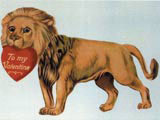Cupid makes a killing
The Christians adapted St Valentine’s Day from a pagan festival, says Quentin Newark, but did they intend to turn it into something so soulless?

St Valentine’s Day is one of those annual events, like Christmas, that doesn’t really mean anything, but you feel obliged to respond to it. It is all so ruthlessly commercial, you suspect Valentine’s Day is actually Valentine’s DayTM, owned by WH Smith.
Shop windows, magazines, Web banners, television programmes and adverts unavoidably announce the day’s coming, and do so with predictable graphic ingredients: hearts, fat angels, arrows and lashings of red. The graphics seem to be impervious to change, as though rules have been laid down by some higher authority in a far distant era.
To some extent this is true. One series of cards produced in the US recycles images from Valentine’s cards of 50 and 100 years ago. The cards are striking because, coming from history, they seem slightly surreal and dream-like: a lion (for courage?) presenting a heart with his mouth, a couple on either side of a see-saw with the message, ‘Quit see-sawing and be my Valentine.’ The style of the images is quaint and distant, but the messages are strangely contemporary. Evidence suggests our modes of communication grow more sophisticated, but our emotions don’t.
The heart as a symbol of life and passion has great antiquity, and is found as far back as the marks on cave walls. The Bible says: ‘They are not dead who live on in our hearts.’ The heart is our essence, our feelings. What kind of person you are is determined by your heart – the ancient Egyptians depicted the human heart being weighed on a set of scales, balanced by the feather of truth.
Like all these things, Valentine’s Day is a Christianised version of something pagan, a Roman festival called Lupercalia, before which men and women swapped names written on slips of paper. The person whose name was on your slip would be your ‘partner’ through all the days and nights of the festival. But although sex is part of Valentine’s Day, as writer Louisa Young points out, ‘You don’t send a Valentine to a one-night stand, no matter how orgasmic it was.’ On the contrary, the heart represents love, and although that may have a sexual dimension, it also has emotional, even spiritual dimensions. It represents the best of what we are.
One of the greatest, if not the greatest, logos of all time is Milton Glaser’s ‘I Love New York,’ the fat one red heart and three blue, typewriter letters. It is great because it represents how we want to feel about everything in our lives: we want pure, deep, lasting feelings.
Modern marketing being what it is, every niche is filled; there are gifts and cards to suit everyone. For clubbers, there are cards covered in red and pink camouflage with the message ‘sweet surrender.’ For the refined sensibility there are Matisse’s beautiful black and white lino cuts of cavorting lovers. Alongside this, there is also a new level of frankness. One card is particularly succinct – it says simply: ‘Fuck me senseless.’
The really curious thing is this: the packaging declares that the card is ‘blank, to allow for a personal message.’ What more could you possibly want to add?
-
Post a comment



